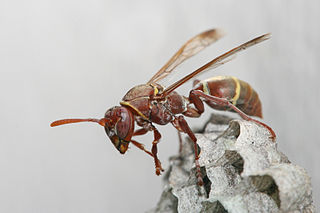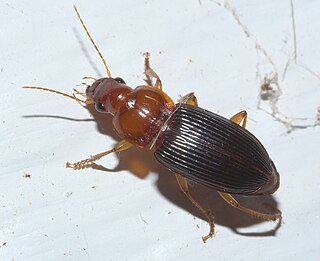
The European roller is the only member of the roller family of birds to breed in Europe. Its overall range extends into the Middle East, Central Asia and the Maghreb.

The cinereous bunting is a bird in the bunting family Emberizidae, a passerine family now separated by most modern authors from the finches, Fringillidae. This species was first described by Christian Ludwig Brehm.

The Polistinae is a subfamily of eusocial wasps belonging to the family Vespidae. They are closely related to the wasps and true hornets of the subfamily Vespinae, containing four tribes. With about 1,100 species total, it is the second-most diverse subfamily within the Vespidae, and while most species are tropical or subtropical, they include some of the most frequently encountered large wasps in temperate regions.

Colymbetes is a genus of beetles native to the Palearctic, including Europe, the Nearctic, the Near East and North Africa.
Nicrophorus semenowi is a burying beetle described by Edmund Reitter in 1887. It is endemic to China where it is known from the provinces of Gansu, Qinghai, and Tibet.
Strigopteroides is a genus of beetles in the family Buprestidae, containing the following species:
Eocarterus is a genus of beetles in the family Carabidae. It contains eight species divided into two subgenera, Eocarterus and Baeticocarus.
Cymindis semenowi is a species of ground beetle in the subfamily Harpalinae. It was described by V. E. Jakovlev in 1890.
Harpalus semenowi is a species of ground beetle in the subfamily Harpalinae. It was described by Tschiterscherine in 1901.

Chlorion is a genus of Hymenoptera of the Wesergton Sphecidae family of wasps.
Caelostomus semenowi is a species of ground beetle in the subfamily Pterostichinae. It was described by Tschitscherine in 1898.

Polistes austroccidentalis is a kleptoparasitic paper wasp that is found in several regions of high altitude in Europe, and until 2017 was universally mistakenly referred to as Polistes semenowi, which is instead the correct name of the species formerly known as "Polistes sulcifer". As one of only four obligate parasites in the subgenus Polistes, it uses the nests of other paper wasps to rear its young. To evade detection by the host nest, P. austroccidentalis employs mimicry by adjusting its cuticular hydrocarbons to match those of the host. Once the host nest has been infiltrated, the parasitic female physically attacks the host queen to subdue her and become the colony's new queen. P. austroccidentalis displays several morphological adaptations for parasitism such as increased mandible size and an enlarged Van der Vecht's organ. This species is unusual because it does not have the ability to produce workers and is only able to produce individuals who have the capacity to reproduce.

Polistes semenowi is a species of paper wasp in the genus Polistes that is found in southeastern and southern central Europe, as well as central Asia, and was until 2017 erroneously known by the name Polistes sulcifer, while a different species was incorrectly believed to represent P. semenowi. It is one of only four known Polistes obligate social parasites, sometimes referred to as "cuckoo paper wasps", and its host is the congeneric species Polistes dominula. As an obligate social parasite, this species has lost the ability to build nests, and relies on the host workers to raise its brood. P. semenowi females use brute force, followed by chemical mimicry in order to successfully usurp a host nest and take over as the queen.
Eocarterus esau is a species of ground beetle in the genus Eocarterus. It was discovered by the zoologist Heyden in 1885.
Eocarterus amicorum is a species of ground beetle in the genus Eocarterus. It belongs to the subgenus Baeticum. E. amicorum has a very limited geographical range, being present in only Spain.
Eocarterus baeticus is a species of ground beetle in the genus Eocarterus.
Eocarterus chodshenticus is a species of ground beetle in the genus Eocarterus. It is common in the Zarafshan Range of Uzbekistan, wherein populations of the beetle increase with increasing altitude.
Eocarterus propagator is a species of ground beetle in the genus Eocarterus.
Eocarterus tazekensis is a species of tiger beetle in the genus Eocarterus and subgenus Eocarterus.

Harpalini is a tribe of a diverse group of ground beetles belonging to the subfamily Harpalinae within the broader family Carabidae. The tribe contains more than 1,900 species.







